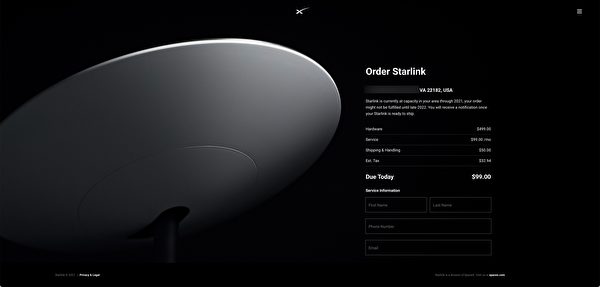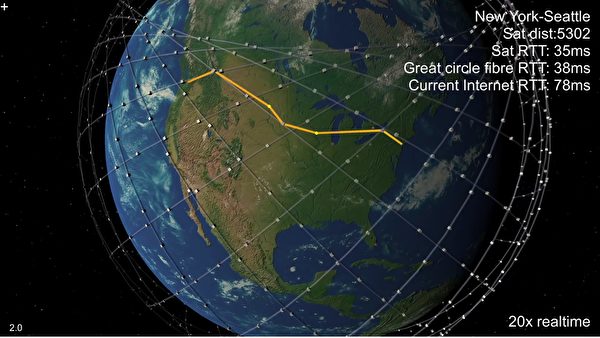[The Epoch Times, June 26, 2021](The Epoch Times reporter Wu Ruirui interviewed and reported) The “Starlink” project owned by American billionaire Elon Musk has recently attracted attention. “Starlink”‘s space exploration company SpaceX announced that it will reach 100% global satellite network services in September. Musk also recently mentioned that “Starlink” will go public once it has enough predictable cash flow. Another thing that many people are concerned about but not reported by the mainstream media is the potential of “Starlink” to surpass the CCP’s network firewall. The next step for Hong Kongers whose freedom of information is disappearing is the real-name calling card system that came into effect in September. Is “Starlink” a future option to surf the Internet without censorship?
Starlink’s satellite broadband service began to accept pre-orders in Hong Kong in February. After entering the address of the Hong Kong government on June 25, the feedback received is: Currently “Starlink” has reached capacity saturation in your area. Your order may not be fulfilled until around the end of 2022. Availability depends on regulatory approval. Users can pay a $99 deposit to purchase a satellite antenna router package.
Compared with the actual measurement at the end of February, the service information is more accurate. At that time, the “Starlink” service website stated that it was scheduled to serve the Hong Kong region in 2022, and did not mention that it would require regulatory approval in 2021.
Entering the address in the suburbs of Virginia near Washington DC, the capital of the United States, produces an order including an antenna of 499 yuan, which is also saturated. According to SpaceX’s announcement, “Starlink” has received 500,000 pre-orders and promised that the first batch of US test users will receive a network speed of 50 MB to 150 MB per second, which is lower than the average network speed enjoyed by general US broadband network users ( 191MB).

Low-orbit satellite relay signals can bypass firewalls
At present, the “Starlink” program has provided testing services in 11 countries and regions. It is estimated that 12,000 Low Earth Obit (LEO) satellites will be deployed by 2024 at a cost of approximately US$10 billion, 2000 kilometers away from the earth. the following). SpaceX has obtained permission from the Federal Communication Commission (FCC) to launch these 12,000 near-Earth satellites. The number of satellites that have been launched into space orbit is 1,800.
Generally well-known communication satellites, three geostationary orbit (GEO, Geostationary Orbit, about 36,000 kilometers above the earth’s equator) satellites can cover the entire earth. GEO is a satellite whose position relative to the earth remains unchanged. The advantage is that the coverage area is large, but the signal strength is low, the requirements for the ground receiving equipment (antenna) are high, and the signal delay (latency) is long.
LEO satellites are satellites whose positions relative to the earth are constantly changing. The advantage is that the signal delay is short, the intensity is concentrated, and the antenna requirements are not so high, but to complete the signal transmission task, multiple satellites are often relayed. And this relay can be achieved through an earth station, or through direct signal transmission between satellites.
A vice president of engineering management of a satellite company told The Epoch Times that at present, the signals between Starlink satellites still have to be transmitted through ground stations, but direct signal transmission between satellites is possible, especially in the future. After the number has increased a lot. The satellite expert did not have the company’s official authorization to discuss this issue, so he accepted an interview with Epoch Times reporters on condition of anonymity.
If it is transmitted through a ground station, the approval of the local country is required. But even now, some satellite companies ignore this, and the country where the ground station is located “opens one eye and closes one eye.” In other words, these countries have not pursued satellite companies that have ground station services but are not licensed. If direct transmission between satellites is achieved, the local country’s permission is not required. And if you want to interfere with satellite signals, it is difficult to do so. One reason is that there are many low-orbiting satellites, and they cannot effectively lock the target when they are constantly moving relative to the ground. Another reason is that if you interfere with the signal of the same frequency, it will interfere with all the working satellites in the frequency, which is unrealistic.
As for the network service provided by satellites, as long as the signal is transmitted to areas not controlled by the firewall to access the Internet, such as the United States, then it is not controlled by the firewall of the Chinese Communist Party.
If I bought an antenna in the United States or South Korea or anywhere, can I still use it in Hong Kong? The vice president of satellite engineering said that the service will not be affected. As long as “Starlink” does not close the service, users can continue to use it. That is to say, in terms of technology, “Starlink” provides Hong Kong residents with a way to access the Internet beyond the control of the CCP’s firewall, which is possible.


Will SpaceX help promote freedom of information?
The Epoch Times asked SpaceX whether SpaceX would allow antennas purchased outside Hong Kong to receive “Starlink” services in Hong Kong. The other party did not reply before the deadline.
Back in January 2015, when Musk first launched his global Internet project at SpaceX’s new satellite factory in Seattle, he was asked about the CCP’s control of the Internet. Without permission, will SpaceX continue to provide uncensored Internet in China?
His answer at the time was that he would not, because “If they are dissatisfied with us, they can blow up our satellite, which is not good.”
And Musk has never promoted his “Starlink” plan from the level of opponents of the firewall. However, the online YouTube Applico channel said that Musk and the US government not only cooperate closely with the Department of Energy and the Aerospace Agency, but also with the Department of Defense. He said that as far as he knows, both SpaceX and the US government are very interested in the role of the “Starlink” program and the freedom of dissemination of information.
According to the aforementioned satellite experts, the cost of the $500 antenna provided by Starlink is between $2,500 and $3,000, so Musk is burning a lot of money. And Starlink’s direct competitor OneWeb started earlier than Starlink, but went through bankruptcy and reorganization. In comparison, “Starlink” is very successful, largely because of Musk’s huge investment. Now everyone is grabbing the orbital slot on the low-orbit satellite orbit, which is first-come, first-served. The “kick” of SpaceX’s launch of satellites also helped its satellites quickly occupy low orbits.
According to relevant research and calculations of Guotai Junan Securities, in the next 10 years, the scale of satellites in the continental low-orbit satellite system is expected to reach the level of 3,000 to 6,000. And Musk will reach more than 10,000 by 2024.
Taiwanese economist Wu Jialong said in an interview with “The Epoch Times” earlier that Musk’s Tesla (Tesla) electric car is currently facing more and more difficulties in the mainland. He was accused of “spy car” and accused of “braking.” “Failure” may mean that “the drunkard is not interested in drinking”, but it is actually aimed at “Starlink”.
He said, “In the future, the entire world and all parts of the world will have access to the Internet, which means that the CCP’s network firewall will be breached. This matter may be even more serious. Because this problem is a matter of the party’s survival for the CCP.”
Editor in charge: Lian Shuhua#
.
